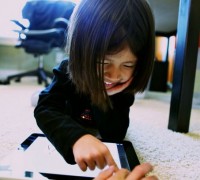“Whether or not you realize it, you’re setting up a digital trail for your children that can last through their lifetime, and you’re doing it without your permission”
Psychological implications of growing up without anonymity
 Cutesy photos may be harmless now, but they might pose a problem in years to come. This is why experts strongly recommend making sure that whatever images or anecdotes parents post are things their children will feel comfortable with later in life.
Cutesy photos may be harmless now, but they might pose a problem in years to come. This is why experts strongly recommend making sure that whatever images or anecdotes parents post are things their children will feel comfortable with later in life.
“Whether or not you realize it, you’re setting up a digital trail for your children that can last through their lifetime, and you’re doing it without your permission,” Greenberg says.
Kathryn Tuggle of Main Street explains that children can also be very sensitive about their appearance during their tween years. “If you post photos of your child during an ‘ugly duckling’ phase, you could be setting them up for self-esteem issues in the future.”
Another danger is “branding” your child. If you continually post pictures of them crying or clinging to you with captions like, “He’s so cranky,” or “She’s so shy,” it’s also possible you could be shaping your children’s perception of themselves. Hence, think about what’s best for your child, not you, the next time you log on to social media.
To read more about privacy setting pluses and the problems with privacy settings, click here.
‘Oversharenting’
Sharing too much information about one’s kids online has become too commonplace that according to Time, a term has already been coined for this: oversharenting. It is understandable that parents would want to share the growth and development of their children, but there’s also a fine line between posting family pictures and cutesy photos of baby’s first bath. You never know where your kid’s pictures might end up someday.
“Anytime you post anything on social media, you’re losing a little bit of control over what happens to that image,” says clinical psychologist Barbara Greenberg through Main Street. “There are people out there who are bad. There are stalkers and malicious people who can take your pictures and put them on sites where heads end up on other people’s bodies… Socially isolated people who spend all day on Facebook stalking people, who get turned on by children,” Greenberg adds, emphasizing how as parents, we have to think about how much we’re going to post.
Joining the bandwagon is never a good reason to post something. “There may be pressure to show off your baby, but you don’t have to join that club. It’s always your decision.”
What you can do
Some parents go to extreme measures of literally posting nothing about their kids at all, but for those who still want to share photos or videos of their beautiful brood to some extent online, here are some tips that might be helpful:
- If you shall decide to keep your child off social media, cull your friend list and let them know about your intention of doing so.
- You may also use a pet name, rather than your child’s real name, to afford him/her some protection against companies or individuals who might be interested in your child’s personal data.
- Avoid tagging your child’s photos on Facebook lest you want to the facial recognition tool to work on him/her.
- Lock down your privacy settings to prevent strangers from viewing your pictures and posts.
- Lastly, and most importantly, use the internet consciously and in a way that is effective and positive for your life.

Here are other interesting and worthwhile reads on sharing about your child on social media:
- About My Recovery’s “Why parents should care about their kid’s digital footprint” – Multi-awarded mom blogger Noemi Lardizabal-Dado’s shares about why you need to keep your children (especially teenagers) safe and secure on the internet, and how. Join her parenting workshop titled ‘Keeping My Kid’s Digital Footprint Safe’ on February 28 at Mothercare, Podium. For more information, visit the Manila Workshops’s official website.
- The Bump’s “Are you sharing too much about your baby online?” – This sheds light on what people think is unacceptable when it comes to sharing (or oversharing) about baby online.
- Mommyish’s “8 things
I wouldn’t know about your kid if Facebook didn’t exist” – A funny take on the excesses parents tend to share about their kids over the popular social networking site. Examples include “the exact millisecond of conception” and “way too much information about bodily functions.” - iMore’s “How to create a new child ID for family sharing” – a step-by-step guide for iPhone users who want to keep their child’s photos within the family.
*“Mother and Child Reflected” by William Pitcher, courtesy of Flickr.
written by Edel Cayetano as originally posted at the Philippine Online Chronicles


















 Luijoe’s first Halloween in 1994 was spent at his aunt’s village. She started the Trick or Treat experience in her own village. 1994 saw the year when malls and the like started to sell costumes and more Halloween decors. My husband just adored his little boy. It’s no wonder that Halloween is such a painful experience for my husband. The past years, he used to hibernate in our bedroom avoiding the little kids knocking at our doors. But that is just how he was then. I love giving candies to these kids as I imagine my precious Luijoe hovering nearby. I am sure Luijoe is around me all the time.
Luijoe’s first Halloween in 1994 was spent at his aunt’s village. She started the Trick or Treat experience in her own village. 1994 saw the year when malls and the like started to sell costumes and more Halloween decors. My husband just adored his little boy. It’s no wonder that Halloween is such a painful experience for my husband. The past years, he used to hibernate in our bedroom avoiding the little kids knocking at our doors. But that is just how he was then. I love giving candies to these kids as I imagine my precious Luijoe hovering nearby. I am sure Luijoe is around me all the time. My little boy posed his cutest smile ever. “sigh” I miss my boy. As I gathered the photos for this entry, I could not help turning misty-eyed pouring over these precious memories . “Was he really that cute?” “How I wish I can just rewind the past and hug him all over again!” Pictures and memories are what is left of him. Of course, his love rings true in my heart. But yes, I digress. And the tears well up again as I write this.
My little boy posed his cutest smile ever. “sigh” I miss my boy. As I gathered the photos for this entry, I could not help turning misty-eyed pouring over these precious memories . “Was he really that cute?” “How I wish I can just rewind the past and hug him all over again!” Pictures and memories are what is left of him. Of course, his love rings true in my heart. But yes, I digress. And the tears well up again as I write this.



 After
After 








